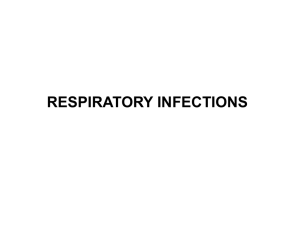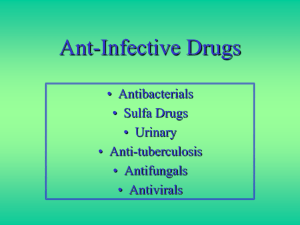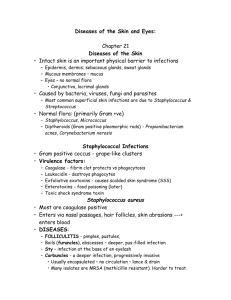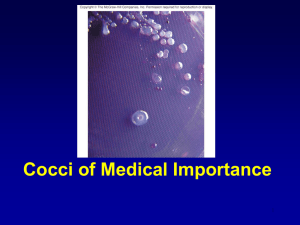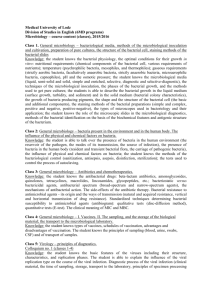Chapter 19: Infectious Diseases Affecting the Skin and Eyes
advertisement
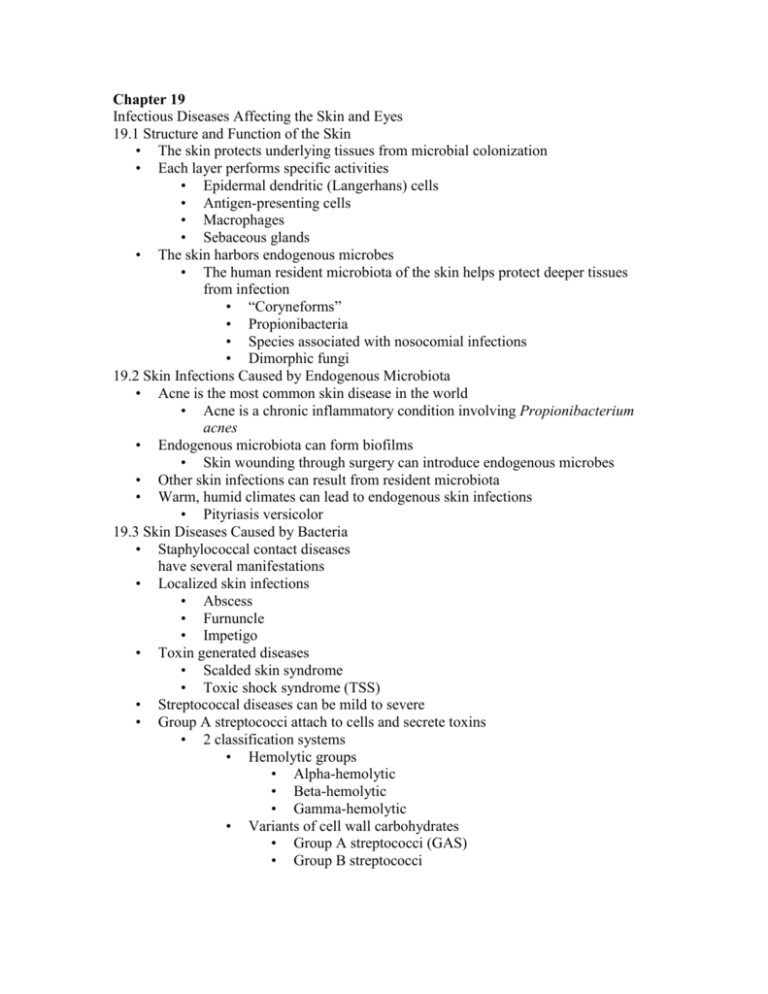
Chapter 19 Infectious Diseases Affecting the Skin and Eyes 19.1 Structure and Function of the Skin • The skin protects underlying tissues from microbial colonization • Each layer performs specific activities • Epidermal dendritic (Langerhans) cells • Antigen-presenting cells • Macrophages • Sebaceous glands • The skin harbors endogenous microbes • The human resident microbiota of the skin helps protect deeper tissues from infection • “Coryneforms” • Propionibacteria • Species associated with nosocomial infections • Dimorphic fungi 19.2 Skin Infections Caused by Endogenous Microbiota • Acne is the most common skin disease in the world • Acne is a chronic inflammatory condition involving Propionibacterium acnes • Endogenous microbiota can form biofilms • Skin wounding through surgery can introduce endogenous microbes • Other skin infections can result from resident microbiota • Warm, humid climates can lead to endogenous skin infections • Pityriasis versicolor 19.3 Skin Diseases Caused by Bacteria • Staphylococcal contact diseases have several manifestations • Localized skin infections • Abscess • Furnuncle • Impetigo • Toxin generated diseases • Scalded skin syndrome • Toxic shock syndrome (TSS) • Streptococcal diseases can be mild to severe • Group A streptococci attach to cells and secrete toxins • 2 classification systems • Hemolytic groups • Alpha-hemolytic • Beta-hemolytic • Gamma-hemolytic • Variants of cell wall carbohydrates • Group A streptococci (GAS) • Group B streptococci • Group A streptococci • Streptococcal pharyngitis • Strep throat • Cellulitis • Erysipelas • Streptococcal toxic shock syndrome • Necrotizing fasciitis • Other wounds also can cause skin infections • Traumatic wounds to the skin surface can lead to localized infections • Gangrene • Gas gangrene or myonecrosis • Cutaneous anthrax • Wound cellulitis • Animal bites can puncture the skin • Bacterial disease can arise from animal bites or scratches • Pasteurellosis • Cat-scratch disease (CSD) • Rat-bite fever 19.4 Diseases of the Skin Caused by Herpesviruses • Human Herpes Simplex Infections Are Widespread and Often Recurrent • Cold sores are contagious sores caused by HSV-1 • After primary infection, the viruses become latent in sensory ganglia • Recurrence of cold sores occurs when viruses are reactivated and move to the epithelium • Chickenpox Is No Longer a Prevalent Disease in the United States • A vaccine using attenuated viruses became available in 1995 • It is a highly communicable disease caused by the varicella-zoster virus (VZV) • It is transmitted by skin contact and respiratory droplets • A red, itchy rash spreads across the entire body and turns into fluid-filled vesicles • The itchy vesicles break open and yield highly infectious virus-laden fluid • The most common complication is bacterial infection of the skin • Pneumonia, encephalitis, or Reye syndrome may also occur Shingles is an adult disease caused by the same virus as chickenpox • After infection, VZV can remain in nerve cells for many years • If they are reactivated, they can travel to the body trunk and cause blisters and patches of red • It can also cause facial paralysis and severe “ice-pick” pains • It can occur repeatedly • Postherpetic neuralgia is the persistence of shingles pain for years after the blisters have disappeared • Human Herpesvirus 6 Infections Primarily Occur in Infancy • It causes roseola infantum, marked by • high fever • subsequent red rash • It is spread through contact with respiratory secretions or saliva • Many bone barrow transplant recipients suffer an HHV-6 viremia after transplantation • Some researchers believe the virus lies dormant for years and may be associated with multiple sclerosis later in life • A Few Herpesvirus Infections Are Oncogenic • The Epstein-Barr virus (EBV) and the human herpesvirus-8 (HHV-8) are oncogenic • Kaposi sarcomic is an angiogenic tumor of the blood vessel walls • It is most commonly seen in immunocompromised individuals, such as AIDS patients • It is caused by HHV-8, forming dark or purple skin lesions 19.5 Other Viral Diseases of the Skin • Paramyxovirus Infections Can Cause Typical Childhood Diseases • Measles (rubeola) is a highly contagious disease caused by a member of the Paramyxoviridae family • Transmission occurs through respiratory droplets • Koplik spots are red patches with white grain-like centers that appear along the gum line – They appear 2–4 days after the onset of symptoms • The characteristic red rash begins as maculopapules at the hairline, spreading to the – face – trunk – extremities • Complications include – bacterial disease in the respiratory tissue – panencephalitis • Vaccine is given in the measles-mumps-rubella (MMR) inoculation • Rubella (German Measles) Is an Acute, Mildly Infectious Disease • It is caused by a virus of the Togaviridae family • It is transmitted by respiratory droplets or contact • Symptoms of rubella include an occasional fever and pale-pink maculopapular rash • Recovery is usually prompt, but relapses can occur • Congenital rubella occurs when the fetus is infected through the placenta • Children may be born with problems in the – eye – ear – heart • Fifth Disease (Erythema Infectiosum) Produces a Mild Rash • It is caused by a member of the Parvoviridae • • Transmission occurs through respiratory droplets Symptoms include a fiery red rash on the cheeks and ears, and trunk • It disappears within a few days • Adults can experience symptoms similar to those of rheumatoid arthritis • Some Human Papillomavirus Infections Cause Warts • Common warts are usually benign skin growths resulting from a specific strain of HPV • Plantar warts occur on the soles of the feet • They can be transmitted by contact with – an affected person – a contaminated object Poxviruses Have Had Great Medical Impacts • Smallpox (variola) is contagious and sometimes fatal • Pink-red macules appear on the face and trunk • They then become papules and fluid-filled vesicles • The vesicles become pustules that break open and emit puss, leaving pitted scars (pocks) • Vaccinations ceased in the United States in 1972 after eradication occurred, so many people are not immune • Smallpox is one of the most dangerous weapons of bioterrorism 19.6 Skin Diseases Caused by Fungi Parasites • Dermatophytosis is an infection of the skin, hair, and nails • Sporotrichosis is an occupational hazard • Sporothrix schenkii forms subcutaneous lesions • Leishmania can cause cutaneous infections 19.7 Structure and Function of the Eye • Ocular infections involve external structures or internal sites • The major defense mechanisms are tears and the conjunctiva • The eye may contain an endogenous microbiota • An ocular microbiota may help protect the eye from infection 19.8 Infectious Disease of the Eye • Some bacterial eye infections can cause blindness • Bacterial eye infections can involve the eyelid, cornea, or conjunctiva • Bacterial conjunctivitis • Trachoma • A few viruses and parasites are associated with eye infections • Viral and parasite eye infections involve the conjunctiva or cornea • Viral pink eye • Acute conjunctivitis • Pharyngoconjunctival fever • Acanthamoeba keratitis (AK) • Ochocerciasis – Intermediate host – Definitive host • River blindness
